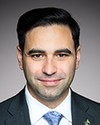Thank you, Chair.
Indeed, the members voted for the motion, but it's the how that we're talking about. Now we're talking about amendments. We're very concerned that the very prescriptive nature of some of the amendments and motions that we are seeing coming forward will, I will say, not only hurt the study that we have agreed to do but, in fact, jeopardize its very utility to the Canadian people, because it would rightfully—and this is the risk that apparently other members are willing to take—be seen as just a partisan hack job.
I would like to remind members that we did hear from CRA officials. It was a very interesting meeting, and members certainly availed themselves of the ability not only to ask very detailed questions of the CRA officials but to request those replies in writing.
I thank the clerk for forwarding the replies that we received. I find it very pertinent that, in those replies, we have the answers that we are looking for. I think they were given verbally, but it's always clearer when you have a document in black and white.
There was one question from Mr. Lawrence concerning what the penalty would be if a charity wilfully put the incorrect name on a donation receipt. There was some discussion about what the penalty was. The official said at the time that she would come back with the answer. What's interesting about the answer is that, apparently, it's not necessary to identify donors. You can have an anonymous donor. It only becomes an issue if the donor asks for a tax receipt for deduction purposes. That makes sense, because, for the Canada Revenue Agency, it is the Income Tax Act that is their primary concern and that, indeed, charities do not issue donations to an incorrect name of someone who would then claim the charitable donation credit when, in fact, the gift did not come from that entity.
When there is an incident, when they identify it during an audit.... I like the incremental process they take, because maybe it was a mistake. Maybe it was human error. Maybe it was lack of education. As we know, charities very often have volunteers working for them. Not everyone is an expert in this area, so they give the charity a chance to correct its non-compliance with an education letter.
If it's not corrected, then they will move to a compliance agreement, which is something that's a principle of justice we have in this country—that people are given a chance to do better and to comply. We have seen that before where even members of Parliament make errors in the conduct of various activities, but they will be spoken to and advised and in some cases given, and they sign, a compliance agreement saying they will do better.
Of course, in the event of someone wilfully then doing the same or failing to correct their error, then there are penalties. In this case, the CRA responded that the issuing of a receipt to a wrong name could be assessed at a penalty equal to 125% of the eligible amount. In this way we have the assurance that the CRA has tools that, when they are made aware...and I'm going to get to the section I know many members were interested to hear about, which is how the CRA decides who they're going to investigate, because we want to make sure that they're going to investigate X, Y, and Z.
Here we have the assurance that there is a process and indeed they have fully provided an annex with a complete list of penalties and sanctions for registered charities, which is not confidential information. It can be found on the CRA website along with, of course, a list of registered charities that anyone can consult, and indeed they should do so. Of course, the ultimate.... I think it probably could go further to charges, but certainly their registration would be withdrawn in that case.
There were other answers to questions that members had posed.
I did want to say that a disbursement quota is not something that everyone is familiar with, but indeed if charities do not disburse funds according to their mandate to the minimum that is prescribed by the Canada Revenue Agency Act, then that penalty is that much greater because the whole purpose of the charity is to collect donations that the donors can then receive receipts for and then they can get a reimbursement on their taxes. There's a monetary benefit involved. If these charities then do not disburse their funds in accordance to CRA rules, it could constitute fraud.
Sometimes again it's a charity where the people who are operating it are not experts in the area. They don't understand the rules, so the CRA will work with the charity. However, they will indeed revoke the registration of charities and they have. It was Madam Sinclair-Desgagné who asked for an example and further explanation on that. The CRA responded that since 2006-07, indeed 25 charities have been revoked. The registration for 25 charities have been revoked for reasons that included a disbursement quota shortfall.
Again, this is information that they were happy to provide to the committee members here. They do give examples, which I won't repeat here. Personally, I don't see the benefit of naming and shaming when there could be any kind of reason. Sometimes it's the death of the founder of the charity. I've sat on boards before. It's a lot of work. I would hesitate to say that anyone who starts a charity with the intention of defrauding the Canadian taxpayer.... That's usually not the purpose, but things can happen. We can be assured that the CRA is attentive to those matters.
What I did want to get to was the question regarding the number of leads. That was Mr. Desjarlais. I appreciate that question because it gives us an idea of what the universe was like. Is it one or is it...? As it turned out, it's something in the area of 30,000. Did I read that correctly? A leads program typically receives over 30,000 leads from the public on cases of alleged tax or benefit cheating each year. I believe that can include individuals as well as businesses and charities. That is very interesting.
I know the classic, of course, is a falling out between partners or spouses or whatever. The first call after the divorce lawyer, apparently, is to the CRA. People do need to bear that in mind. Your private information may not be so private.
We were assured here by Mr. Hamilton and his officials that every lead that comes to them is looked at one way or the other. Now perhaps members might ask whether other departments that we work with in the government have the same standard of practice. I would venture to say that, where there is the possibility of collecting money, there's a particular motivation that comes into play. I am glad to see that this kind of due diligence is at play.
Can we know who the folks are that are named on these leads? Can we know what the outcome is? If it's one of us that provides the lead, will we get a personal report? We heard from the officials that the answer is no on those lines. Again, they are directed under Canadian legislation, as part of the authorities that they have to conduct this work, to keep it private. No one wants to hear about a leak from CRA. Nobody wants that.
The repercussions of a leak do not bear contemplating. I dare say that I'd be the first in line—and I know I'd have colleagues with me—demanding for the head of any official who allowed a leak to occur. That information is kept private, but those investigations are undertaken. Eventually, if they do fall into the public view in a court scenario, and so on, we do have the results and rightfully so. As we know, in our system of justice, one is innocent until proven guilty, and rightfully so.
I find this so reassuring to know we can ask questions and get these kinds of detailed answers. I will have more to say, because I'm still looking through the documents the clerk provided, but I would like to hear from other colleagues on this topic.
I thank you very much, Chair, for giving me the floor.






